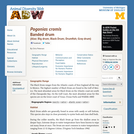
Pogonias cromis: Information
- Subject:
- Life Science
- Zoology
- Material Type:
- Reading
- Provider:
- University of Michigan Museum of Zoology
- Provider Set:
- Animal Diversity Web
- Author:
- Chris Peterson (author), University of Michigan
- Date Added:
- 07/24/2001

Pogonias cromis: Information
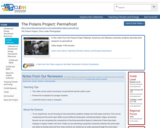
In this video from the Polaris Project Website, American and Siberian university students describe their research on permafrost.
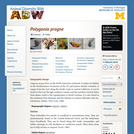
Polygonia progne: Information

Waterwheels are devices that generate power and do work. Student teams construct waterwheels using two-liter plastic bottles, dowel rods and index cards, and calculate the power created and work done by them.
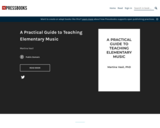
A textbook on teaching elementary general music.
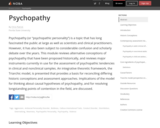
Psychopathy (or “psychopathic personality”) is a topic that has long fascinated the public at large as well as scientists and clinical practitioners. However, it has also been subject to considerable confusion and scholarly debate over the years. This module reviews alternative conceptions of psychopathy that have been proposed historically, and reviews major instruments currently in use for the assessment of psychopathic tendencies in clinical and nonclinical samples. An integrative theoretic framework, the Triarchic model, is presented that provides a basis for reconciling differing historic conceptions and assessment approaches. Implications of the model for thinking about causal hypotheses of psychopathy, and for resolving longstanding points of contention in the field, are discussed.
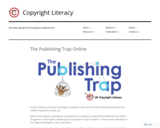
The Publishing Trap is an open educational board game designed to teach researchers, academics, doctoral students, librarians and other professionals in higher education about the impact of publishing and scholarly communication choices they make throughout their career. Following the COVID-19 pandemic the game has been shifted to be played online using virtual classroom / webinar software (e.g Zoom, Microsoft Teams). The team nature of the game requires break-out room functionality to allow each team to confer during each round of the game.

On the topic of energy related to motion, this summary lesson is intended to tie together the concepts introduced in the previous four lessons and show how the concepts are interconnected in everyday applications. A hands-on activity demonstrates this idea and reinforces students' math skills in calculating energy, momentum and frictional forces.
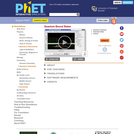
Explore the properties of quantum "particles" bound in potential wells. See how the wave functions and probability densities that describe them evolve (or don't evolve) over time.
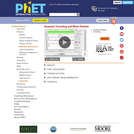
Watch quantum "particles" tunnel through barriers. Explore the properties of the wave functions that describe these particles.
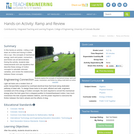
In this hands-on activity rolling a ball down an incline and having it collide into a cup the concepts of mechanical energy, work and power, momentum, and friction are all demonstrated. During the activity, students take measurements and use equations that describe these energy of motion concepts to calculate unknown variables, and review the relationships between these concepts.
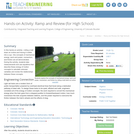
In this hands-on activity rolling a ball down an incline and having it collide into a cup the concepts of mechanical energy, work and power, momentum, and friction are all demonstrated. During the activity, students take measurements and use equations that describe these energy of motion concepts to calculate unknown variables and review the relationships between these concepts.
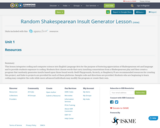
This lesson integrates coding and computer science into English Language Arts for the purpose of fostering appreciation of Shakespearean wit and language and to provide students exposure to coding. Students first choose words that carry insulting connotations from a Shakespearean play and then create a program that randomly generates insults based upon those found words. Swift Playgrounds, Scratch, or Raspberry Pi are recommended resources for creating this project, and links to projects are provided for each of these platforms. Sample code and directions are provided. Students who are beginning to learn coding may complete the code while more advanced individuals may modify the program or create their own.
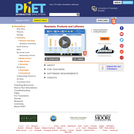
Create your own sandwich and then see how many sandwiches you can make with different amounts of ingredients. Do the same with chemical reactions. See how many products you can make with different amounts of reactants. Play a game to test your understanding of reactants, products and leftovers. Can you get a perfect score on each level?

Because ESL Level 1 students may not all be at the same level, some of the readings may be too difficult for some students. However, the emphasis in these activities is to work on reading strategies for all levels of reading, both at the students' level and above it as well.This module can be combined with the others uploaded about grammar, teaching sentence structure, and writing activities to create an entire OER based ESL class for this level.
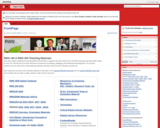
This wiki contains materials for teaching RWS 100 and 200. It supports the work carried out in the RWS teaching internship (RWS 796A) for new TAs. We will use it to share and discuss resources for teaching, pedagogy, and professional development. You are also invited to use it to share work, draft teaching materials, add links, think out loud, introduce yourself, etc.

An OER database of public domain/creative commons books and websites dedicated to Tennessee history. Includes several interviews with Tennesseans on a variety of issues.
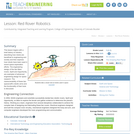
This lesson will start with a brief history of robotics and explain how robots are beneficial to science and society. The lesson then will explore how robots have been used in recent space exploration efforts. The engineering design of the two Mars rovers, Spirit and Opportunity, will be used as prime examples. Finally, the maneuverability of their robotic arms and the functionality of their tools will be discussed.

This webinar addresses questions related to writing, reviewing, editing, or funding a study using the Registered Report format, featuring Chris Chambers and ...
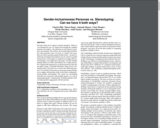
CITATION: Gender-Inclusiveness Personas vs. Stereotyping: Can We Have it Both Ways? Charles Hill, Maren Haag, Alannah Oleson, Chris Mendez, Nicola Marsden, Anita Sarma, Margaret Burnett, ACM Conference on Human Factors in Computing Systems (CHI'17), May 2017, pp. 6658-6671. ABSTRACT: Personas often aim to improve product designers' ability to "see through the eyes of" target users through the empathy personas can inspire - but personas are also known to promote stereotyping. This tension can be particularly problematic when personas (who, of course as "people" have genders) are used to promote gender inclusiveness - because reinforcing stereotypical perceptions can run counter to gender inclusiveness. In this paper we explicitly investigate this tension through a new approach to personas: one that includes multiple photos (of males and females) for a single persona. We compared this approach to an identical persona with only one photo using a controlled laboratory study and an eye-tracking study. Our goal was to answer the following question: is it possible for personas to encourage product designers to engage with personas while at the same avoiding promoting gender stereotyping? Our results are encouraging about the use of personas with multiple pictures as a way to expand participants' consideration of multiple genders without reducing their engagement with the persona. VIDEO: https://www.youtube.com/watch?v=6f1aJhWGfLM